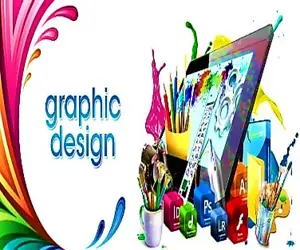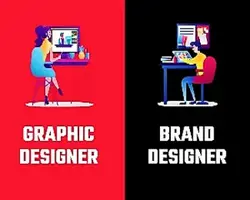Graphic design is a craft in which professionals make visual content to communicate messages. By applying visual hierarchy and page layout techniques, designers use typography and images to meet users’ particular needs and focus on the logic of displaying elements in interactive designs, to optimize the user experience.
Contents
What is Graphic designing
If you are looking for answers to your question ‘what is a graphic design course’, read on. Graphic designing is an ancient art which was used extensively in Egyptian hieroglyphics to convey messages and stories. Today, it has evolved and extended its application across sectors. Graphic design bring together pictorial and textual elements to convey a message to the viewer. From marketing to academics, the applicability of graphic designing is immense.

This increased the demand for skilled graphic designers. If you are wanted to pursuing a career as a graphic designer, it helps to enroll in a professional graphic design training course with one of the reputable graphic design institutes such as DOTNET Institute.
Different types of Graphic designing
A decade ago, graphic design was identified as creative that published in print media or movie posters and advertisements. There are currently three types of graphic design
Website Design
Graphic designing has become highly digitized due to the demand for websites and social media handles for businesses and governments across the world. It is used for building websites and includes creating the overall layout, color scheme, and navigation.
User Experience Design
As the name suggests, it aims to ensure an easy and satisfying viewing experience for the users of the website or application. Graphic designers step into the user’s shoes and create designs that focus on value, adaptability, usability, and desirability in a website.
Motion Graphics
Also called animation, motion graphics are gaining popularity because it can help increase the likelihood of engagement with a target audience. It is commonly used in movies, TV shows and even sports.
If you are looking to become a professional graphic designer, this is the right time! With digital engagement increasing day by day, a skilled and trained graphic designer can easily find high paying employers. If you want to learn then the first step for you is to find the right institute when you may learn the essentials from qualified tutors. A quick online search on ‘graphic design courses near me’ will help you find the suitable option.
A Brief History of the Term "Graphic Designing"
In the grand scheme of human history, art and communication, “graphic design” is a relatively new concept. The first recorded use of the term was a 1908 San Francisco educational trade manual for printers and a 1918 advertisement for a course on “graphic design and lettering” at the California School of Arts and Crafts, Berkeley.
Graphic design, as an anonymous concept, certainly existed a long time ago. But when the term first appeared in an academic context, it laid the groundwork for graphic design to become a formal process, strategy, and even philosophy that could be learned. Now, it no longer describes a certain thing, but something that can change, something that the viewer can literally interact with. Although it has brought many new disciplines to the graphic design field, the underlying principles and purposes of visual communication have remained the same through the ages.
How does graphic design work
We’ve talked about how graphic design uses visuals to convey information, if information is what we are after, a block of explanatory text would get the job done.
But graphic designers take that block of raw text and use their expertise to creatively style and format information.
The effect is to make the content more aesthetically pleasing, which means an audience is more likely to read and retain the information.

This gets to the heart of the benefit of visual communication.
It immediately strikes the viewer’s emotions. People understand scenes on an intuitive level while words build meaning over time, built into sentences and paragraphs to get a point across.
Essentially, visual communication is about bonding with the audience and understanding which visuals will get them noticed.
To harness the power of visuals, designers break them down to their most fundamental elements and apply tried-and-true principles to make them speak.
Also check:
-
5 Best Computer Course in India for Private Job (India में प्राइवेट नौकरी के लिए 05 BEST कंप्यूटर कोर्स)
-
Google jobs in India | Google में चाहिए नौकरी तो कर ये 5 कोर्स - मिलेगा लाखों का पैकेज | Google Jobs
-
Retail Management Career | Retail Jobs | How to get Retail Management Job
-
How to Start Earning as a Graphic Designer?
-
Paramedical Courses | Paramedical Career | कम बजटऔर कम फीस में मेडिकल करियर बनेगा
What are the elements of Graphic Designing
Graphic designers sort the different types of visuals they have to work with into what are called elements of design
Color– Colors are strongly associated with emotions but yes they are also grounded in science.
Type– In addition to what the words themselves say, the form and styling of the letters make a particular impression.
Shape– Shape is the foundation of all things visible, and it may be molded into its own language.
Line-Lines may enclose, direct attention, and make movement.
What are the principles of graphics
Design principles describe techniques for organizing the above design elements into an aesthetically pleasing structure
Balance and Alignment – The design creates order by using symmetry and positioning on the canvas.
Contrast – Design elements should interact with each other, and their differences can be exaggerated for effect.
Emphasis – The design must choose which information to prioritize over others (usually through contrast and proportion).
Movement – The design (even when standing still) can suggest movement and energy.
Proportion – Uses size and weight (thickness) to differentiate design elements.
Repetition – The design uses rhyming elements to promote cohesion.
Space – The empty (or negative) space on the canvas is critical to separation
How does graphic design compare to other design disciplines?
There are many creative disciplines that relate to graphic design (with more being added as new technology comes along). While there are many specialties that overlap with graphic design, there are some notable distinctions to be made
Brand Design
Brand design is the process of strategically building a brand’s identity, from its look and feel to its values and tone. Visual identity design phase (logo, color scheme, brand typography, etc.) – Branding is a holistic process that incorporates traits outside the visual realm (such as brand voice and personality).

UX Design
UX Design – UX stands for User Experience, and is a creative field largely found in digital design. UX designers focus less on particular visuals and more on interactivity, which informational and interactive flow will work best for the user and make it easier for them to complete their tasks through an app.
Game Design
Game design refers to the rules and systems of the game, how it works, what it takes to win or lose. Characters and environmental artists create the actual visuals of the game. Graphic designers are usually involved in visuals such as in-game menus, a game’s logo, and cover art.
Art
The main difference is the idea of ”art for the sake of art”. Art can protect its audience in a way that design cannot. For example, consider architectural design: When designing a building, the architect can be creative in terms of façade, materials, floorpan, etc., but at the end of the day, a building has to fulfill its function to house. And be navigable to humans.
The Process of Graphic designing
So how exactly is a graphic design created? Every graphic designer will have their own process, but the following represents the most basic steps.
Project Brief
At the beginning of the process, the client is responsible for writing a creative brief that explains the project scope, artistic direction, business background information and expected deliverables. Most importantly, it should define the problem the design is meant to solve. Also during this phase, a client will search for a graphic designer, evaluate their portfolio, submit a brief, and negotiate prices and terms.
Research
While the client must provide information about the target audience and competitors, the graphic designer will also conduct research, merging this data with an understanding of graphic design history and trends. Since design is about visual communication.
Ideation
The graphic designer will come up with a possible design solution to the brand’s stated problem. This is often in the form of short (for example, in a mind map) and/or loosely listing words related to the main ideas from sketching designs. Essentially, this stage is about coming up with the underlying concept of the design.
Rendering
Once a concept has been chosen, the graphic designer will take their preferred sketch and render it into a presentable image. In other words, it is the stage where the actual design is made. A printer or software developer (depending on whether the material is physical or digital) will take that image file and create the finished product.
Feedback
A finished design is never really finished. Once a presentable rendered version of the design is created, the graphic designer will show it to the client to get feedback – notes for improvements based on their brand or general impression. This phase may also include audience feedback gathered from user testing (especially in the case of an interactive digital design).
Conclusion
Success in graphic design begins with recognizing the talent and desire for creative communication in print and digital media. The foundation for meeting essential educational requirements begins with high school coursework, upon which college-level classes build. Graphic designers conceptualize, develop and bring into existence visual solutions to address problems in communication. Graphic design encompasses an exciting variety of electronic and print media, photography, animation, layout, and the use of color to effectively and efficiently communicate a concept or message to an audience. An inherent creative and artistic ability is a prerequisite requirement.
FAQs
Graphic design is a craft where professionals create visual materials to communicate messages. By applying visual hierarchy and page layout techniques, designers use typography and illustrations to meet the specific needs of users and focus on the logic of displaying elements in an interactive design to optimize the user experience.
Graphic design not only makes something look good, it organizes information to help deliver a message in the most effective way possible. When you combine the right image, a well-written headline, professionally executed into a well-established package, then BOOM! The message has hit its target.
Graphics are visual elements often used to point readers and viewers toward specific information. They are also used to supplement text in an attempt to aid readers in understanding a particular concept or to make the concept more clear or interesting.
This is an essential skill to make your own graphic design and there is no way to avoid it either. Almost each job post required applicants to be well spoken in using those programs. In fact, Photoshop, Illustrator and InDesign are some of the most requested skills in our sample of job postings.
Graphic design is a great career for those who are creative thinkers and enjoy art, technology and communication. Design is needed in every industry, so graphic designers have many opportunities to take on many new and exciting projects.
Graphic design is a great career for people who are creative thinkers and enjoy art, technology and communication Design is needed in every industry, so graphic designers have many opportunities to take on many new and exciting projects.
Depending on the institution, this can be a three- or four-year degree, but all degrees will focus on subjects that include:
- Drawing
- Photography
- Design technology
- Art theory
- Visual communication theory
- Illustration
- Digital Design
Important topics covered in Graphic Design course are Interaction Design, Communication and Media Theory, Typography, Digital Tools, Illustration, etc.


